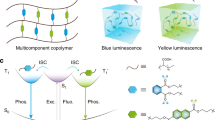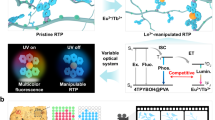Abstract
Organic persistent room-temperature phosphorescent (RTP) materials are promising for applications requiring the secure recording and anti-counterfeiting features owing to their appealing optical properties. Several critical challenges, such as the difficulty to obtain high-quality patterns over large areas and low security levels, need to be addressed to meet the requirements for commercial purpose. Here, we prepared a series of quaternary phosphonium salts with different alkyl chains, which showed interesting organic persistent RTP. The ionic characteristics and the alkyl chains of these molecules impart abundant weak intermolecular interactions. This confers the molecules a high crystallinity, which helps to preserve the persistent RTP properties and cover large areas. Moreover, the RTP lifetime of these organic salts varies over a wide range (1.27 to 884.71 ms) and can be tuned by simply changing the alkyl chain length and counterions, which opens new possibilities in multi-level information encryption applications. It is believed that the engineering of organic salts with tunable persistent RTP lifetimes and large-area printing can promote early-stage demonstrations of security applications into mature commercialization.

摘要
有机室温磷光材料因其独特的光物理性质, 在安全记录和防 伪领域展现出了巨大的应用前景. 然而, 基于这类材料制备的防伪 图案或标签存在分辨低、安全性低、不易大面积加工等缺点, 极 大地限制了其大规模商业化应用. 本文设计、合成了一系列含不 同长度烷基链的有机膦盐来解决以上问题. 这类有机膦盐晶体中 存在较强的分子内/间相互作用, 使得它们具有高结晶能力, 因此 在经过研磨后仍然具有超长室温磷光. 此外, 通过改变烷基链长度 和卤素离子, 实现了室温磷光寿命的大范围调控(从1.27 ms到 884.71 ms), 并利用商用喷墨打印机成功实现了多重信息加密和防 伪.
Similar content being viewed by others
References
Ren W, Lin G, Clarke C, et al. Optical nanomaterials and enabling technologies for high-security-level anticounterfeiting. Adv Mater, 2020, 32: 1901430
Shoji Y, Ikabata Y, Wang Q, et al. Unveiling a new aspect of simple arylboronic esters: long-lived room-temperature phosphorescence from heavy-atom-free molecules. J Am Chem Soc, 2017, 139: 2728–2733
Kenry, Chen C, Liu B. Enhancing the performance of pure organic room-temperature phosphorescent luminophores. Nat Commun, 2019, 10: 2111
Hirata S. Recent advances in materials with room-temperature phosphorescence: photophysics for triplet exciton stabilization. Adv Opt Mater, 2017, 5: 1700116
An Z, Zheng C, Tao Y, et al. Stabilizing triplet excited states for ultralong organic phosphorescence. Nat Mater, 2015, 14: 685–690
Xie Y, Ge Y, Peng Q, et al. How the molecular packing affects the room temperature phosphorescence in pure organic compounds: ingenious molecular design, detailed crystal analysis, and rational theoretical calculations. Adv Mater, 2017, 29: 1606829
Li W, Huang Q, Mao Z, et al. Selective expression of chromophores in a single molecule: soft organic crystals exhibiting full-colour tunability and dynamic triplet-exciton behaviours. Angew Chem Int Ed, 2020, 59: 3739–3745
Zhao W, He Z, Lam JWY, et al. Rational molecular design for achieving persistent and efficient pure organic room-temperature phosphorescence. Chem, 2016, 1: 592–602
He Z, Gao H, Zhang S, et al. Achieving persistent, efficient, and robust room-temperature phosphorescence from pure organics for versatile applications. Adv Mater, 2019, 31: 1807222
Mane SKB, Mu Y, Ubba E, et al. Tuning the organic persistent room-temperature phosphorescence through aggregated states. J Mater Chem C, 2019, 7: 15219–15224
Li D, Lu F, Wang J, et al. Amorphous metal-free room-temperature phosphorescent small molecules with multicolor photoluminescence via a host-guest and dual-emission strategy. J Am Chem Soc, 2018, 140: 1916–1923
Ma X, Xu C, Wang J, et al. Amorphous pure organic polymers for heavy-atom-free efficient room-temperature phosphorescence emission. Angew Chem Int Ed, 2018, 57: 10854–10858
Yang X, Yan D. Strongly enhanced long-lived persistent room temperature phosphorescence based on the formation of metal-organic hybrids. Adv Opt Mater, 2016, 4: 897–905
Gong Y, Zhao L, Peng Q, et al. Crystallization-induced dual emission from metal- and heavy atom-free aromatic acids and esters. Chem Sci, 2015, 6: 4438–4444
Li B, Gong Y, Wang L, et al. Highly efficient organic room-temperature phosphorescent luminophores through tuning triplet states and spin-orbit coupling with incorporation of a secondary group. J Phys Chem Lett, 2019, 10: 7141–7147
Bian L, Shi H, Wang X, et al. Simultaneously enhancing efficiency and lifetime of ultralong organic phosphorescence materials by molecular self-assembly. J Am Chem Soc, 2018, 140: 10734–10739
She P, Yu Y, Qin Y, et al. Controlling organic room temperature phosphorescence through external heavy-atom effect for white light emission and luminescence printing. Adv Opt Mater, 2019, 8: 1901437
Zhen X, Tao Y, An Z, et al. Ultralong phosphorescence of water-soluble organic nanoparticles for in vivo afterglow imaging. Adv Mater, 2017, 29: 1606665
Wang T, Su X, Zhang X, et al. Aggregation-induced dual-phosphorescence from organic molecules for nondoped light-emitting diodes. Adv Mater, 2019, 31: 1904273
Zhou B, Yan D. Hydrogen-bonded two-component ionic crystals showing enhanced long-lived room-temperature phosphorescence via TADF-assisted förster resonance energy transfer. Adv Funct Mater, 2019, 29: 1807599
Li H, Li H, Wang W, et al. Stimuli-responsive circularly polarized organic ultralong room temperature phosphorescence. Angew Chem Int Ed, 2020, 59: 4756–4762
Cai S, Shi H, Li J, et al. Visible-light-excited ultralong organic phosphorescence by manipulating intermolecular interactions. Adv Mater, 2017, 29: 1701244
Yang J, Zhen X, Wang B, et al. The influence of the molecular packing on the room temperature phosphorescence of purely organic luminogens. Nat Commun, 2018, 9: 840
Xue P, Wang P, Chen P, et al. Bright persistent luminescence from pure organic molecules through a moderate intermolecular heavy atom effect. Chem Sci, 2017, 8: 6691
Gu L, Shi H, Bian L, et al. Colour-tunable ultra-long organic phosphorescence of a single-component molecular crystal. Nat Photonics, 2019, 13: 406–411
Yuan J, Chen R, Tang X, et al. Direct population of triplet excited states through singlet-triplet transition for visible-light excitable organic afterglow. Chem Sci, 2019, 10: 5031–5038
Tao Y, Chen R, Li H, et al. Resonance-activated spin-flipping for efficient organic ultralong room-temperature phosphorescence. Adv Mater, 2018, 30: 1803856
Chen G, Guo S, Feng H, et al. Anion-regulated transient and persistent phosphorescence and size-dependent ultralong afterglow of organic ionic crystals. J Mater Chem C, 2019, 7: 14535–14542
Chen G, Feng H, Feng F, et al. Photophysical tuning of organic ionic crystals from ultralong afterglow to highly efficient phosphorescence by variation of halides. J Phys Chem Lett, 2018, 9: 6305–6311
She P, Ma Y, Qin Y, et al. Dynamic luminescence manipulation for rewritable and multi-level security printing. Matter, 2019, 1: 1644–1655
Lu Y, Zhao J, Zhang R, et al. Tunable lifetime multiplexing using luminescent nanocrystals. Nat Photon, 2014, 8: 32–36
Frisch MJ, Trucks GW, Schlegel HB, et al. Gaussian 09. Wallingford: Gaussian, Inc., 2009
Gao X, Bai S, Fazzi D, et al. Evaluation of spin-orbit couplings with linear-response time-dependent density functional methods. J Chem Theor Comput, 2017, 13: 515–524
Hirata S. Roles of localized electronic structures caused by π degeneracy due to highly symmetric heavy atom-free conjugated molecular crystals leading to efficient persistent room-temperature phosphorescence. Adv Sci, 2019, 6: 1900410
Gu L, Shi H, Gu M, et al. Dynamic ultralong organic phosphorescence by photoactivation. Angew Chem Int Ed, 2018, 57: 8425–8431
Mao Z, Yang Z, Fan Z, et al. The methylation effect in prolonging the pure organic room temperature phosphorescence lifetime. Chem Sci, 2019, 10: 179–184
Acknowledgements
We thank the financial support from the National Funds for Distinguished Young Scientists (61825503), the National Natural Science Foundation of China (62075101, 21701087 and 61775101), the National Program for Support of Top-Notch Young Professionals, and the Postgraduate Research & Practice Innovation Program of Jiangsu Province (46030CX18010).
Author information
Authors and Affiliations
Contributions
She P, Ma Y, Zhao Q and Huang W conceived the idea for this paper and designed the experiments. She P and Qin Y performed the synthesis and security printing experiments. Li F, Lu J, Hu H, Liu X and Liu S contributed to the implementation of the experiments and measurements. Ma Y, She P and Zhao Q analyzed the data and wrote the manuscript. Liu S revised the manuscript and provided some suggestions. All authors discussed the results and commented on the manuscript.
Corresponding authors
Additional information
Conflict of interest
The authors declare no conflict of interest.
Yun Ma obtained his MSc degree from Nanjing University of Posts and Telecommunications in 2012, under the supervision of Prof. Qiang Zhao and his PhD degree from Hong Kong Baptist University in 2015, under the supervision of Prof. Wai Yeung Wong. He is currently an associate professor at Nanjing University of Posts and Telecommunications. His research focuses on the development of stimuli-responsive materials for advanced optical applications.
Qiang Zhao received his PhD degree in 2007 from Fudan University. He then became a postdoctoral fellow at Nagoya University in Japan. He joined Nanjing University of Posts & Telecommunications in 2008. He was promoted as a full professor in 2010. His research area is organic optoelectronics, including the design, synthesis and excited-state tuning of organic semiconductors for applications in optoelectronic devices and biomedical fields.
Wei Huang received his PhD degree from Peking University in 1992 and carried out postdoctoral research in the National University of Singapore. In 2001, he was appointed as a chair professor at Fudan University, where he founded and chaired the Institute of Advanced Material. His research interests include the synthesis, structures, and performance of organic/flexible optoelectronic materials and devices.
Rights and permissions
About this article
Cite this article
She, P., Qin, Y., Ma, Y. et al. Lifetime-tunable organic persistent room-temperature phosphorescent salts for large-area security printing. Sci. China Mater. 64, 1485–1494 (2021). https://doi.org/10.1007/s40843-020-1544-6
Received:
Accepted:
Published:
Issue Date:
DOI: https://doi.org/10.1007/s40843-020-1544-6




